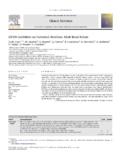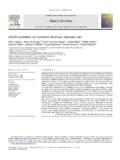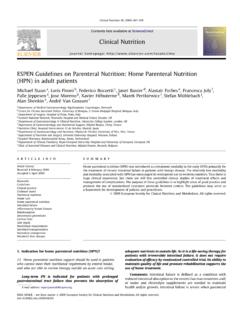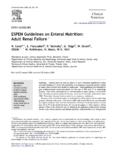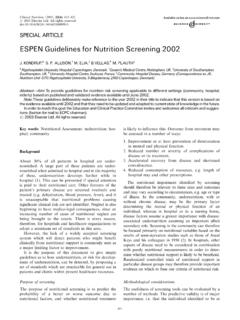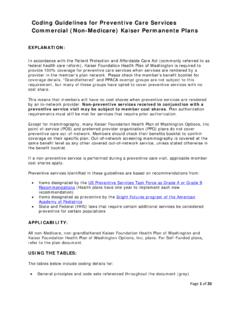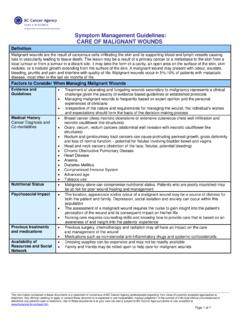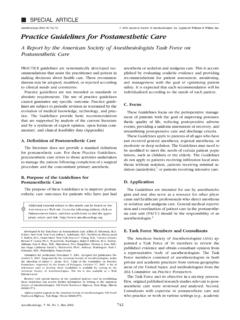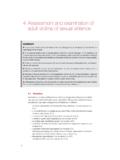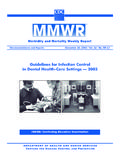Transcription of ESPEN Guidelines on Enteral Nutrition: Intensive care
1 Clinical nutrition (2006)25, 210 223 ESPEN GUIDELINESESPEN Guidelines on Enteral nutrition : Intensive care $ Kreymanna, , Bergerb, Deutzc, M. Hiesmayrd, P. Jolliete,G. Kazandjievf, G. Nitenbergg, G. van den Bergheh, J. Wernermani,DGEM:$$C. Ebner, W. Hartl, C. Heymann, C. SpiesaDepartment of Intensive care Medicine, University Hospital Eppendorf, Hamburg, GermanybSoins Intensifs Chirurgicaux et Centre des Bru les, Centre Hospitalier Universitaire Vaudois (CHUV) , Lausanne, SwitzerlandcDepartment of Surgery, Maastricht University, Maastricht, The NetherlandsdDepartment of Anaesthesiology and Intensive care , Medical University of Vienna, Vienna, AustriaeDepartment of Intensive care , University Hospital Geneva, Geneva, SwitzerlandfDepartment of Anaesthesiology and Intensive care , Military Medical University, Sofia, BulgariagDepartment of Anaesthesia, Intensive care and Infectious Diseases, Institut Gustave-Roussy,Villejuif, FrancehDepartment of Intensive care Medicine, University Hospital Gasthuisberg, Leuven, BelgiumiDepartment of Anaesthesiology and Intensive care Medicine, Karolinska University Hospital, Huddinge,Stockholm, SwedenReceived 20 January 2006.
2 Accepted 20 January 2006 KEYWORDSG uideline;Clinical practice;Evidence-based; Enteral nutrition ;Tube feeding;Oral nutritional sup-plements;Parenteral nutrition ;Immune-modulatingnutrition;Sum maryEnteral nutrition (EN) via tube feeding is, today, the preferred way offeeding the critically ill patient and an important means of counteracting for thecatabolic state induced by severe diseases. These Guidelines are intended to giveevidence-based recommendations for the use of EN in patients who have acomplicated course during their ICU stay, focusing particularly on those who developa severe inflammatory response, patients who have failure of at least one organduring their ICU Guidelines were developed by an interdisciplinary expert group inaccordance with officially accepted standards and are based on all relevant publica-tions since 1985.
3 They were discussed and accepted in a consensus should be given to all ICU patients who are not expected to be taking a full oraldiet within three days. It should have begun during the first 24 h using a standardARTICLE IN $ - see front matter&2006 European Society for Clinical nutrition and Metabolism. All rights $For further information on methodology see Schu tz et further information on definition of terms see Lochs et Corresponding author. Tel.: +49 40 42803 7010; fax: +49 40 42803 ( Kreymann).$$The authors of the DGEM (German Society for Nutritional Medicine) Guidelines on Enteral nutrition in Intensive care areacknowledged for their contribution to this care ;Undernutrition;Malnutrition;Catabol ism;Prognosis;Outcomehigh-protein formula.
4 During the acute and initial phases of critical illness anexogenous energy supply in excess of 20 25 kcal/kg BW/day should be avoided,whereas, during recovery, the aim should be to provide values of 25 30 total kcal/kg BW/day. Supplementary parenteral nutrition remains a reserve tool and should begiven only to those patients who do not reach their target nutrient intake on is no general indication for immune-modulating formulae in patients withsevere illness or sepsis and an APACHE II Score415. Glutamine should besupplemented in patients suffering from burns or full version of this article is available European Society for Clinical nutrition and Metabolism. All rights IN PRESSS ummary of statements: Intensive careSubjectRecommendationsGrade69 NumberIndicationsAll patients who are not expected to be on a full oraldiet within 3 days should receive Enteral nutrition (EN).
5 C1 ApplicationThere are no data showing improvement in relevantoutcome parameters using early EN in critically , the expert committee recommendsthat haemodynamically stable critically ill patientswho have a functioning gastrointestinal tract shouldbe fed early (o24 h) using an appropriate amount general amount can be recommended as ENtherapy has to be adjusted to the progression/course of the disease and to gut energy supply: during the acute and initial phase of criticalillness: in excess of 20 25 kcal/kg BW/day may beassociated with a less favourable during the anabolic recovery phase, the aimshould be to provide 25 30 kcal/kg with a severe undernutrition should receiveEN up 25 30 total kcal/kg BW/day. If these targetvalues are not reached supplementary parenteralnutrition should be administration of metoclopramide orerythromycin in patients with intolerance to enteralfeeding ( with high gastric residuals).
6 C6 RouteUse EN in patients who can be fed via the is no significant difference in the efficacy ofjejunal versus gastric feeding in critically additional parenteral nutrition in patients whotolerate EN and can be fed approximately to thetarget Guidelines on Enteral Nutrition211 ARTICLE IN PRESSUse supplemental parenteral nutrition in patientswho cannot be fed sufficiently via the Enteral careful parenteral nutrition in patientsintolerant to EN at a level equal to but notexceeding the nutritional needs of the of formulaWhole protein formulae are appropriate in mostpatients because no clinical advantage of peptide-based formulae could be formulae (formulae enrichedwith arginine, nucleotides andx-3 fatty acids)aresuperior to standard Enteral formulae: in elective upper GI surgical patients (seeguidelines surgery).
7 In patients with a mild sepsis (APACHE IIo15). in patients with severe sepsis, however,immune-modulating formulae may be harmful andare therefore not in patients with trauma (see Guidelines surgery) in patients with ARDS (formulae containingo-3fatty acids and antioxidants). recommendation for immune-modulatingformulae can be given for burned patients due toinsufficient burned patients trace elements (Cu, Se and Zn)should be supplemented in a higher than patients with very severe illness who do nottolerate more than 700 ml Enteral formulae per dayshould not receive an immune-modulating formulaenriched with arginine, nucleotides ando-3 be added to standard enteralformula in burned trauma are not sufficient data to support glutaminesupplementation in surgical or heterogenouscritically ill : Grade of recommendation.
8 Number: refers to statement number within the remarksPatientsA major methodological problem in this chapter arethe terms ICU patients and critically ill as theydo not refer to homogenous populations. Patientsincluded in original trials as well as those consid-ered in review articles vary widely in terms ofdiagnosis, severity of disease, metabolic derange-ments, therapeutic procedures, and gastrointest-inal with other chapters concerningpatients in need of Intensive care (surgery,trauma and transplant patients) is therefore Kreymann et order to minimise overlap, only trials that metthe following criteria were evaluated: The severity of disease could be deduced fromthe available data. The patients included in the study couldnot beexplicitly assigned to categories discussed inother chapters( patients undergoing elec-tive surgery).
9 The patients werenot routinely managedinICUs for a short recommendations are thus focused onpatients who develop an intense inflammatoryresponse with failure of at least one organ orpatients with an acute illness necessitating supportof their organ function during their ICU results were then classified into the follow-ing categories: surgical, medical, trauma, trans-plant, burns and oral intake is almost always impossible in thesepatients, in this chapter the term EN is confinedto tube feeding exclusively without regard to anykind of oral nutritional measuresICU mortality, 28-day mortality and hospital mortal-ity as well as length of stay in ICU or hospital werelisted as primary outcome measures. Data on long-term survival would have been useful but were,unfortunately, not given in any of the studies.
10 Aspost-ICU mortality is high, 6-month mortality wasalso considered a relevant outcome rate of septic complications was listed as asecondary outcome measure. Particular emphasiswas placed on identifying nutrition -related compli-cations, infections, when such information for and implementation ofenteral nutrition (EN)1. When is EN indicated in ICU patients?All patients who are not expected to be on a fulloral diet within 3 days should receive EN (C).Comment:Studies investigating the maximum timeICU patients can survive without nutritional supportwould be considered unethical and are thereforenot to increased substrate metabolism, under- nutrition is more likely to develop in critical illnessthan in uncomplicated starvation or in less acuteillness.

